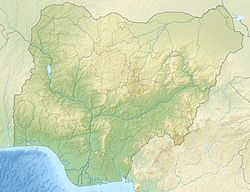Òkè Ọ̀rà | |
 The 650m Ora Hill (Oke Ora) as seen from Ife looking due East. | |
| Location | Ilode II, Ife East Local Government Area, Nigeria |
|---|---|
| Region | Osun State |
| Coordinates | 7°30′28″N 4°37′36″E / 7.50778°N 4.62667°E |
| Altitude | 650 m (2,133 ft) |
| History | |
| Founded | Late Stone Age[1] |
| Abandoned | 900CE (?) |
| Cultures | Early Yorubaland |
| Associated with | Oranfe, Oduduwa |
| Site notes | |
| Excavation dates | 1977 |
| Archaeologists | Omotoso Eluyemi [2][3] |
| Condition | Abandoned. (A small hamlet at the foot of the hill continues to bear the name) |
| Early Yoruba community, The origin of Oduduwa and Oranfe[4] | |
Oke Ora (Yoruba: Òkè Ọ̀rà) is an ancient community and archaeological site situated on a hill about 8 km (5 mi) east of Ufẹ̀ (Ilé-Ifẹ̀), in between the city and the small village of Itagunmodi. Two important characters in the early history of Yorubaland; Oranife (Oramfe) and Oduduwa came from Oke Ora.[5] Several stories and legends of the Yoruba people surround the site. In the Yoruba creation legend, it was the first mound of earth formed from the soil in a snail shell and from which Ife, the first settlement was built. Today, it continues to play an important role in certain religious rites of the Ife people, most significantly, in the coronation rituals of the Ọwọni (Ooni), king of Ifẹ̀.[6][7]
- ^ Bondarenko, Dmitri (1 January 1999). "Benin prehistory: The origin and settling down of the Edo". Anthropos: 4. Retrieved 31 July 2023.
- ^ "West African Journal of Archaeology". West African Journal of Archaeology. 24. editorial board of WAJA: 62. 1994. Retrieved 30 July 2023.
- ^ Shennan, S. J. (20 May 2003). Archaeological Approaches to Cultural Identity. Routledge. p. 207. ISBN 978-1-134-86629-8. Retrieved 30 July 2023.
- ^ Ajayi, J. F. Ade; Crowder, Michael (1976). History of West Africa. Columbia University Press. p. 213. ISBN 978-0-231-04103-4.
- ^ Nwanyanwu, O. J.; Opajobi, Bola; Olayinka, Sola (1997). Education for Socio-economic & Political Development in Nigeria. Visual Resources. p. 159. ISBN 978-978-34467-0-0. Retrieved 1 May 2024.
- ^ Nigeria, Guardian (28 August 2015). "Ife coronation rituals and the primacy of history". The Guardian Nigeria News - Nigeria and World News. Retrieved 30 July 2023.
- ^ "New Ooni of Ife presented with traditional Ade-Are crown - P.M. News". PM News Nigeria. Retrieved 30 July 2023.
© MMXXIII Rich X Search. We shall prevail. All rights reserved. Rich X Search

